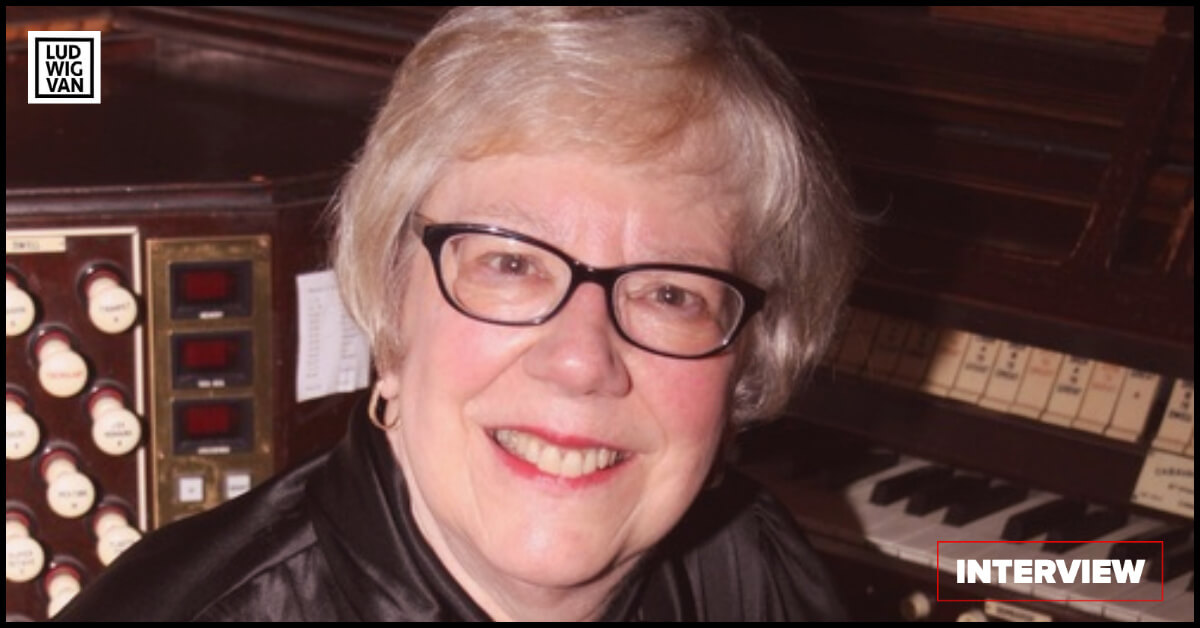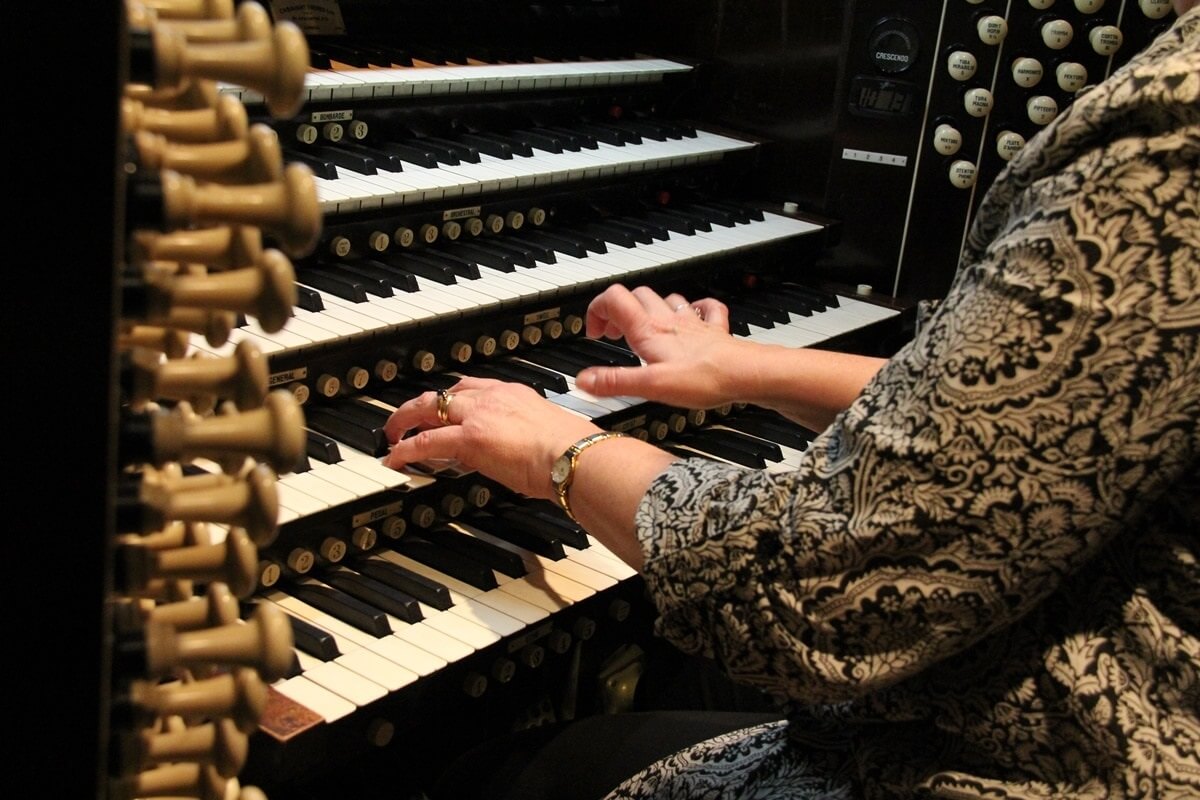
Canada’s largest pipe organ lives in the Metropolitan United Church in a relatively unassuming corner of Toronto’s downtown. For some 35 years, Dr. Patricia Wright has been the person pulling all the stops, as it were, as the church’s Minister of Music, organist, and guardian of the behemoth that is the Casavant Opus 1367.
Wright has recently announced her upcoming retirement, and takes a look back on her career with Ludwig.
The Mighty Casavant Opus 1367
The first organ was installed on site in 1872, but burned down along with the church in 1928. It led to a rebuild, and the Casavant that still sits there today.
- Built by Casavant Frères of Quebec in 1930 with 5 manuals and 121 ranks;
- Upgrades in the 1980s and 1990s;
- A gallery of 7 stops, 2 divisions installed in 1998;
- Currently includes 8,333 pipes and 500 miles of wire.
About Dr. Patricia Wright
Dr. Wright is an accomplished musician who’s left her mark not only in the world of organists, but well beyond.
- Degrees in organ performance from Carnegie-Mellon University, and a Doctor of Musical Arts degree from Yale University;
- Studied in France with Nadia Boulanger and Jean Langlais;
- Founding member of the United Church of Canada Association of Musicians, and past national president of the Royal Canadian College of Organists;
- Adjunct Professor of Organ for the University of Toronto Faculty of Music, and cross-appointed to Emmanuel College for the Master of Sacred Music degree program;
- Covenanted as a Congregational Designated Minister of Music, a first in the United Church of Canada, in September 2010.
She has performed as a recitalist across North America and in Europe. Recently, she collaborated with poet Patricia Orr in releasing Bach in Time: Let There Be Beauty.
The Q&A
What led you to focus on the pipe organ as a musician, and to the position at the Metropolitan?
I first played a little pipe organ — not a very good one — at my home Presbyterian church in small-town Western Pennsylvania, and I loved the intricacy of it and the music — especially Bach; (Bach is still my favourite composer — organ, choral, instrumental). After degree studies in Pittsburgh and New Haven, my first husband and I moved to Ottawa where he was hired to teach at the University of Ottawa. I taught there also — choral, music history, organ — and became organist of First Baptist Church and then Dominion-Chalmers United Church. A job change led us to Guelph, and near the end of our first year there, my predecessor, Dr. Melville Cook, retired from Metropolitan. I applied and was fortunate to be appointed. It has been my life’s greatest honour to be steward of the instrument and of the wonderful musical tradition at Metropolitan.
What does a typical day/week look like at your job?
Pre-pandemic — usually organ practice in the morning, some days have worship planning meetings. Staff meetings, evening Board meetings, Music Committee and Worship Committee meetings, Thursday evening Handbell Choir and Metropolitan Choir rehearsals, teaching my University of Toronto students and our Wayne C. Vance Organ Scholar, time for anthem planning, concert planning and preparation — we usually run a weekly ‘Noon at Met’ series with local organists, vocalists, and instrumentalists — and our Music at Metropolitan concert series.
A normal Sunday would see me arriving early for a bit of warmup on the organ, a 45-minute rehearsal with one of our children’s choirs, a 15-minute warmup with the Metropolitan Choir, and then a 15-minute organ prelude into the Sunday service.
For 45-50 years, Metropolitan has had a Good Friday concert featuring the Metropolitan Festival Choir (our Sunday choir plus others) and orchestra. In the past 35 years, we have had numerous performances of Bach’s St. John Passion, B Minor Mass, Mozart Requiem, Brahms Requiem, Requiems by Rutter and Chilcott, works by Canadian composers, Bach Cantatas, Rachmaninoff Vespers, concerts of poetry and music, et cetera. What an incredible opportunity I have had to present major works!
As well as other vocal, instrumental, and choral concerts, we have presented three full productions of Joseph and His Amazing Technicolour Dreamcoat, and productions of Godspell, Oliver, and this past November’s Music Theatre International’s global event All Together Now. I have a terrific team of wonderful musicians with whom to work to make all of this possible.
Our concert series also has presented some of the world’s finest organists, often in cooperation with the Toronto Centre of the Royal Canadian College of Organists and also the Canadian International Organ Competition.
We also have a new livestream system at Met with multiple cameras and a new sound system.
What’s something about the position that you think the average layperson wouldn’t know about?
While I love playing the organ, actual organ rehearsal and performance are only a small portion of what I do. I spend far more time planning the choral pieces for services and concerts, working with other members of the music staff, working with the ministry staff and other staff members both on worship services and other events at Metropolitan.
What is involved in maintaining Canada’s largest pipe organ?
Over the years, Metropolitan has been determined to maintain both of our historic instruments — the organ and also our historic 54-bell carillon (the first tuned carillon in North America). These instruments are important in Metropolitan’s worship but also in our spiritual outreach to the community and beyond.
The organ has been and continues to be maintained by the Alan T. Jackson Organ Company of Toronto — the representatives of the Casavant company who built both the original 1930 instrument and also the 1998 gallery addition. Each month, we have a half-day visit from the tuners who repair leaks, computer malfunctions, et cetera, as well as tune especially the reed pipes, which are the pipes that go out of tune easily. Thanks to the generosity of donors over the years, we do have a bit of money beyond the yearly budget to help with the inevitable challenges brought on by the dry Canadian winter (wood and leather cracking) and age.

What role did you play in the upgrades and other work that has been done on the organ over the years? It seems like it would be a complicated project in many respects, no matter what the details.
I rely on the experts who are as determined as I am to keep the organ in good shape. Just before I arrived at Met, Dr. Cook had installed the very first ‘memory level’ system — a two-level system that allowed for two sets of pistons (the way we organists save the sounds we need for various pieces). Eventually, we upgraded to what we have now — 200 levels of memory. Also, we have cleaned the reeds, we have re-leathered all the original organ (7,900 pipes each having its own leather pouch), we have made the console electronically controlled which allows us to have it on a movable platform so that the audience can see the organist during a concert.
Looking back, is there anything — an aspect of the job, or perhaps a certain moment or event (or all of the above) — that stands out for you? Is there anything in particular that you learned from the experience overall?
There are so many — those moments in a service or concert when I can feel that the congregation or audience is touched by the music; working with so many wonderful people — my choirs, the ministers and other staff, and especially the children; teaching such gifted young people — we’ve mentored quite a few Organ Scholars at Metropolitan who now are off on their own careers; doing organ demonstrations for the public (and again, children) during ‘Doors Open Toronto’ or after one of our ‘Phantoms of the Organ’ concerts and seeing their eyes light up with the wonder of the organ sounds; taking the choir to Roy Thomson Hall for their 2019 noon Christmas Concert — what a thrill!
I should emphasize that the biggest joy was the addition of the 7-stop, 400 pipe gallery organ in 1998. This certainly adds to the registration possibilities but, most important, supports the congregational hymn singing.
What’s your hope for the future of the Casavant Opus 1367, and the Metropolitan? For organ music in general?
My hope is that this instrument keep inspiring generations of congregations, audiences, and students — and that Metropolitan continues to be a beacon of light and hope in downtown Toronto through its worship, its spiritual outreach of music and arts, and its outreach to the vulnerable population. The organ is still a very exciting, living instrument — using air (like our human voices do) to create sound — I was a juror in this past October’s Canadian International Organ Competition, and we have so many talented young players throughout the world and here in Toronto. We need to keep helping them realise their dreams.
My husband William and I have led two tours of historic German organs, and the delight of our friends and students as they experience the long history of the organ was so exciting.
Any future plans you’d like to share?
I still have degree students to teach, but beyond that, I’ll just see what happens. I have a family including a brand new grandson to enjoy!
#LUDWIGVAN
Get the daily arts news straight to your inbox.



